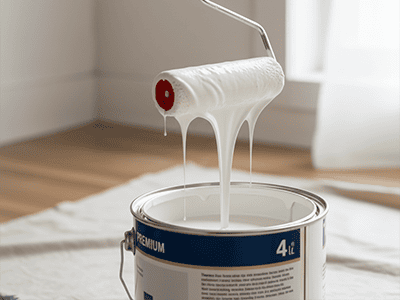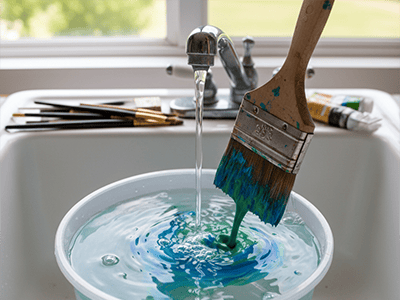How to Clean & Store Brushes and Rollers
The Right Way to Make Your Quality Tools Last
If you’ve invested in good quality painting tools, the last thing you want to do is ruin them after a single use. A high-quality paintbrush can last for years if cared for correctly, while a poorly cleaned roller cover will be useless for your next project. Cleaning up is the least glamorous part of any painting job, but taking 15 minutes to do it properly will save you a significant amount of money in the long run and ensure your tools are in perfect condition for your next project. This guide focuses on cleaning up after using modern water-based (acrylic) paints, which are used in over 90% of home projects in Australia.
First, Get as Much Paint Off as Possible
The goal is to remove the excess paint before you even touch the water. The less paint you have to wash down the drain, the better it is for the environment and the faster your clean-up will be.

- For Brushes: Use the edge of your paint pot or a multi-tool to scrape as much paint as you can from the bristles back into the can. Squeeze the bristles to push out even more.
- For Rollers: This is a crucial step. Use the curved edge of a painter's multi-tool or the back of a knife to scrape the excess paint from the roller cover. Work from one end to the other, rotating the cover as you go. You can recover a surprising amount of paint this way.
Cleaning Your Brushes: The Two-Bucket Method
This method ensures a thorough clean without wasting huge amounts of water.

- The First Wash: Fill a bucket about halfway with water. Vigorously swish the brush around in the water, pressing it against the sides and bottom of the bucket to work the paint out of the bristles, especially from the base (the ferrule).
- The Second Wash (The Rinse): Now, move to a second bucket with clean water (or use a laundry sink). Wash the brush again until the water runs completely clear. This final rinse removes any remaining paint residue.
- Comb and Shape: Use a painter's comb or an old fork to gently comb the bristles straight. This is key to keeping the brush's shape.
- Dry and Store: Squeeze out the excess water. The best way to store a brush is to hang it up to dry. If you can't, lay it flat. Never store a wet brush standing up on its bristles, as this will ruin their shape. Once dry, store it back in the cardboard sleeve it came in.
Cleaning Your Roller Covers
After scraping, cleaning a roller is a straightforward process.
- Remove the Cover: Take the roller cover off the frame. The frame itself just needs a quick wipe down.
- Wash and Squeeze: The easiest way to clean the cover is under a running tap. Use your hands to work the paint out of the fibres, squeezing and rinsing until the water runs clear.
- Spin it Dry: Once clean, put the cover back on the frame. To remove the excess water, place the roller inside an empty bucket and spin it vigorously. The centrifugal force will fling most of the water out.
- Dry and Store: Stand the roller cover on its end to dry. Never store it in a plastic bag while it's still damp, as this can cause it to rot.
Pro Tip from a Sydney Painter
Time is money on a professional job site, so efficient clean-up is essential. We use specialised tools like spinner tools for drying rollers and high-pressure hose attachments for a fast, thorough clean. Caring for our tools is paramount because we know that a well-maintained brush or roller provides a superior finish. At DRJ Painting, our commitment to quality extends all the way through to our clean-up process, ensuring a tidy site and perfectly maintained equipment, ready for the next flawless job.

